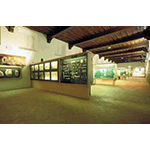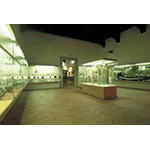Museo Fiorentino di Preistoria "Paolo Graziosi" [Florence Prehistorical Museum "Paolo Graziosi"]
The Museum was conceived in 1946 by the anthropologist Gaetano Pieraccini (at the time Mayor of Florence) and by Paolo Graziosi, anthropologist and palaeontologist. At first its specimens were accessible only to scholars and specialists in this field, while since 1975 the collections have been open to the public.
The Italian collection displays specimens dating from different periods (from the Palaeolitic to the Neolithic, to the Bronze Age) and coming from many Italian sites, such as the Valdarno area, Bibbona (LI), and Ventimiglia. The objects are of various types: stone implements, engraved stones, objects made of bone, carved bones, decorated ceramics, grave goods, metal products, and ornamental objects.
The non-Italian collection contains specimens coming from Asia and America, but above all from Africa, dating from the Palaeolithic and the Neolithic. They consist of stone implements, ceramics, arrowheads, rock carvings (originals and photographic reproductions) representing domestic and wild animals, human beings and abstract figures. Highly interesting are the objects found among the remains of the palafittes on Swiss and French lakes, which include botanical material, fragments of linen fabric and instruments.
The Museum, whose collections are still being incremented today, is also engaged in activities of research and education.
****************************
Texts by Laura Celli
English translation by Catherine Frost
Last update 30/mar/2010





